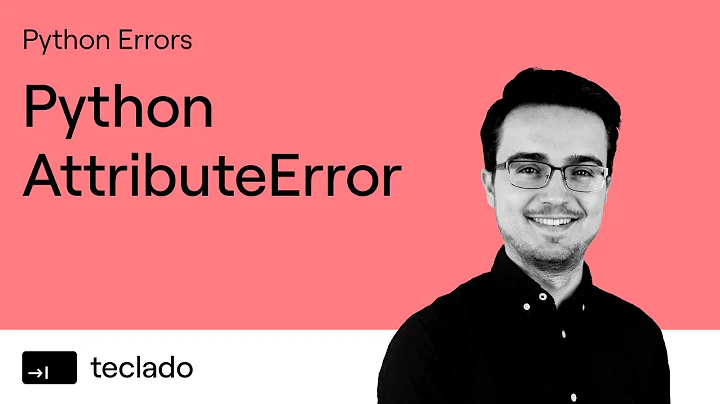numpy.ndarray object has no attribute 'read'(and 'seek')
Solution 1
Here is how I solved the problem(i.e got rid of the error):
##[..]
cv2.imwrite("framex.jpg", frame)
filename = "framex.jpg"
image, image_w, image_h = load_image_pixels(filename, (input_w, input_h))
##[..]
frame = draw_boxes(filename, v_boxes, v_labels, v_scores)
##[..]
Solution 2
seek and read are things that an opened file can do. I deduce from the traceback that this error occurs in the
image, image_w, image_h = load_image_pixels(frame, (input_w, input_h))
line, and the problem must be in the frame argument. That function expects an opened file or filename, but frame apparently is numpy array. It is defined above in:
(grabbed, frame) = vs.read()
So it's a frame from the mp4, an array, not a file.
So either you need to give load_image_pixels a file name, or you need to use some other function to process the frame array.
A general web search doesn't help with this kind of error. It is both too broad and too specific.
no attribute errors in Python are common. It means the object at that point has a different class than what the programmer intended. For example if a cv read can't find the file, it returns a None, instead of an image. You can't process None as though it were an image. But your particular combination of using an array instead of a filename is unique.
Before doing a web search, try to understand where the error occurs, and what variable(s) is involved. Check both it's actual nature (type, shape, etc) and the expectations of the code, the function(s) being called.
Related videos on Youtube
ysquared
Updated on June 04, 2022Comments
-
ysquared almost 2 years
I am getting the error
numpy.ndarray object has no attribute 'read'andnumpy.ndarray object has no attribute 'seek'. I tried looking for the answer online but I failed.What I am trying to do is detect objects in a video - in this case I want to detect zebras.
I took an image detector and I am trying to apply it to video. I am trying to loop over each frame of the video and ultimately passing the frame to the function
draw_boxes.Here is the error message:
Traceback (most recent call last): File "/Users/ysquared/Library/Python/3.7/lib/python/site-packages/PIL/Image.py", line 2770, in open fp.seek(0) AttributeError: 'numpy.ndarray' object has no attribute 'seek' During handling of the above exception, another exception occurred: Traceback (most recent call last): File "<stdin>", line 1, in <module> File "<string>", line 204, in <module> File "<string>", line 118, in load_image_pixels File "/Users/ysquared/Library/Python/3.7/lib/python/site-packages/keras_preprocessing/image/utils.py", line 110, in load_img img = pil_image.open(path) File "/Users/ysquared/Library/Python/3.7/lib/python/site-packages/PIL/Image.py", line 2772, in open fp = io.BytesIO(fp.read()) AttributeError: 'numpy.ndarray' object has no attribute 'read'And here is the relevant code:
model = load_model('model.h5') # define the expected input shape for the model input_w, input_h = 416, 416 # define the anchors anchors = [[116,90, 156,198, 373,326], [30,61, 62,45, 59,119], [10,13, 16,30, 33,23]] # define the labels labels = ["person", "bicycle", "car", "motorbike", "aeroplane", "bus", "train", "truck", "boat", "traffic light", "fire hydrant", "stop sign", "parking meter", "bench", "bird", "cat", "dog", "horse", "sheep", "cow", "elephant", "bear", "zebra", "giraffe", "backpack", "umbrella", "handbag", "tie", "suitcase", "frisbee", "skis", "snowboard", "sports ball", "kite", "baseball bat", "baseball glove", "skateboard", "surfboard", "tennis racket", "bottle", "wine glass", "cup", "fork", "knife", "spoon", "bowl", "banana", "apple", "sandwich", "orange", "broccoli", "carrot", "hot dog", "pizza", "donut", "cake", "chair", "sofa", "pottedplant", "bed", "diningtable", "toilet", "tvmonitor", "laptop", "mouse", "remote", "keyboard", "cell phone", "microwave", "oven", "toaster", "sink", "refrigerator", "book", "clock", "vase", "scissors", "teddy bear", "hair drier", "toothbrush"] vs = cv2.VideoCapture('Zebras.mp4') fourcc = cv2.VideoWriter_fourcc(*'XVID') writer = cv2.VideoWriter('output.avi', fourcc, 20.0, (640, 480)) class_threshold = 0.6 boxes = list() while True: (grabbed, frame) = vs.read() if grabbed==True: image, image_w, image_h = load_image_pixels(frame, (input_w, input_h)) yhat = model.predict(image) for i in range(len(yhat)): # decode the output of the network boxes += decode_netout(yhat[i][0], anchors[i], class_threshhold, input_h, input_w) # correct the sizes of the bounding boxes for the shape of the image correct_yolo_boxes(boxes, image_h, image_w, input_h, input_w) # suppress non-maximal boxes do_nms(boxes, 0.5) # get the details of the detected objects v_boxes, v_labels, v_scores = get_boxes(boxes, labels, class_threshold) # draw what we found frame = draw_boxes(frame, v_boxes, v_labels, v_scores) writer.write(frame) cv2.imshow('frame', frame) if cv2.waitkey(1) & 0xFF == ord('q'): break else: break vs.release() writer.release() cv2.destroyAllWindows() -
ysquared over 4 yearshow do I turn the frame, which, as you said, is numpy array, into a file eg jpg file? So what I am trying to figure out is how to convert the frame, which is a numpy array, into a jpg file such that
load_image_pixelsconsumes the right type. I already triedImage.fromarray,array_to_img, imported from keras.preprocessing.image. If you can help me I will appreciate it. -
hpaulj over 4 yearsIf the
frameis already array, why do you need to useload_image_pixels? Why save it as file only to load it again into an array orkerasstructure? Are you working from a tutorial that is intended for a different kind on input? -
ysquared over 4 years
load_image_pixelsalso returns, along with the image, the image's height and width. The image's height and width are consumed by another function. So that is why I think I need to useload_image_pixels. -
hpaulj over 4 yearsCan't you deduce the height and width from the array?
-
ysquared over 4 yearsthe function
draw_boxesconsumes a filename not an numpy array. Unlikeload_image_pixelsI can't modify this one. To detect objects I needdraw_boxes. So I need to to convert the numpy array to a jpg file. -
hpaulj over 4 yearsDoesn't the
cvlibrary have something that lets you write an array as image file? It can read an image file. -
ysquared over 4 yearsLet us continue this discussion in chat.
![[Solved] AttributeError: 'module' object has no attribute](https://i.ytimg.com/vi/0EO08QEL0Q8/hq720.jpg?sqp=-oaymwEcCNAFEJQDSFXyq4qpAw4IARUAAIhCGAFwAcABBg==&rs=AOn4CLCZM9WzE2C-5Gs3TqGwnAW7QHFodA)




